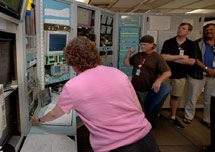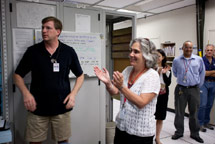
Handy Links
SLAC News Center
SLAC Today
- Subscribe
- Archives: Feb 2006-May 20, 2011
- Archives: May 23, 2011 and later
- Submit Feedback or Story Ideas
- About SLAC Today
SLAC News
Lab News
- Interactions
- Lightsources.org
- ILC NewsLine
- Int'l Science Grid This Week
- Fermilab Today
- Berkeley Lab News
- @brookhaven TODAY
- DOE Pulse
- CERN Courier
- DESY inForm
- US / LHC
SLAC Links
- Emergency
- Safety
- Policy Repository
- Site Entry Form

- Site Maps
- M & O Review
- Computing Status & Calendar
- SLAC Colloquium
- SLACspeak
- SLACspace
- SLAC Logo
- Café Menu
- Flea Market
- Web E-mail
- Marguerite Shuttle
- Discount Commuter Passes
-
Award Reporting Form
- SPIRES
- SciDoc
- Activity Groups
- Library
Stanford
Around the Bay
Hats Off for Top Off
Yesterday, the Stanford Synchrotron Radiation Lightsource reached a milestone years in the making. At 2:00 p.m. on Thursday afternoon, SSRL engineers and physicists achieved "top off injection," whereby they replenished the current within the SPEAR3 storage ring without blocking the X-ray beam headed for selected SSRL beamlines.
Over the course of a workday, synchrotrons—much like people—lose energy. When the current within the SPEAR3 storage ring falls below a certain level, accelerator operators must replenish that energy to keep the X-ray beam created by the electron beam going strong. For the past five years, when the current fell to around 85 milliamps, a loss of about 15 percent, users have been required to shut their beamlines while current was pumped back into the storage ring.
In last week's successful top off injection test, accelerator operators replenished the beam while leaving beamlines 4, 5, 10 and 11 open. This was the culmination of several years of work dedicated to designing, building and installing the equipment needed to ensure there would be no danger of the electron beam escaping into work areas as additional current is delivered.
"It worked," said physicist John Schmerge. "Finally."
The ability to refill the electron beam without closing X-ray beamlines means that researchers will no longer have to pause their data-taking whenever the current falls below 85 milliamps. But, more importantly, it also means that the mirrors and other optical equipment used to focus and shape the X-ray beam will be subjected to less thermal distortion. Each time the beamlines are closed for current to be pumped back into the storage ring and then reopened once the beam is at 100 percent, these devices are walloped with the full current intensity. The strain of going from zero to full power puts stress on these delicate instruments that upsets the precise beam stability needed by the users.
This stress has not been much of a problem with SPEAR3 operating at 100 milliamps. But SPEAR3 was designed to operate at 500 milliamps, and operators plan to begin operating at this higher current sometime in the next few run cycles. At 500 milliamps, opening and closing the beamlines will cause a much higher level of beam instability as the optics are zapped each time with five times the power they receive now. Complicating matters, at 500 milliamps the drop in current will happen much more quickly, requiring accelerator operators to refill the beam much more often.
"Top off injection makes running at 500 milliamps possible," said Bob Hettel, head of the SSRL Accelerator Division. "The ultimate goal is for SSRL to maintain a nearly constant current at 500 milliamps, with the beam current fluctuating a percent or less over the course of a day."
—Brad Plummer
SLAC Today, June 26, 2009

